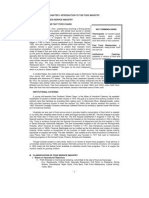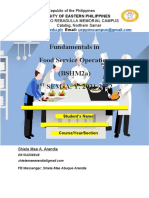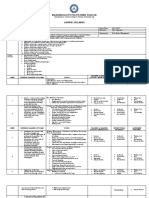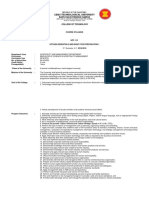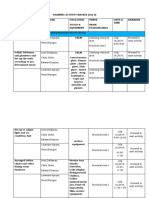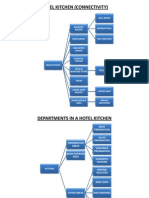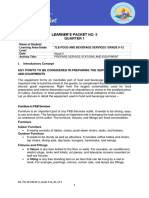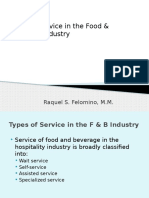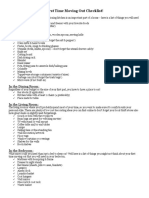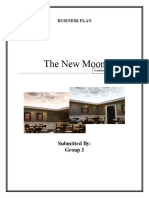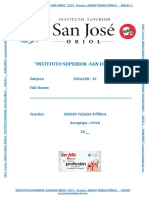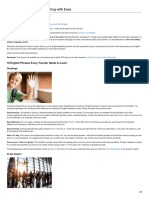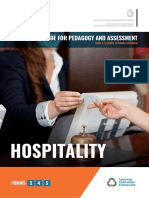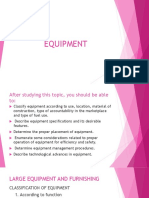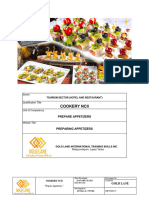Module 1 Cafeteria
Module 1 Cafeteria
Uploaded by
Mary Joy RellonCopyright:
Available Formats
Module 1 Cafeteria
Module 1 Cafeteria
Uploaded by
Mary Joy RellonOriginal Title
Copyright
Available Formats
Share this document
Did you find this document useful?
Is this content inappropriate?
Copyright:
Available Formats
Module 1 Cafeteria
Module 1 Cafeteria
Uploaded by
Mary Joy RellonCopyright:
Available Formats
MODULE 1:
SUBJECT CODE: FSM 7
SUBJECT TITLE:
TIME FRAME:
I. Module Title:
II. Module Description:
This module covers skills, knowledge, and attitudes required to operate
cafeteria and catering services/operation.
As the first module of learning, this will help learners understand the
history and basic concept in cafeteria management. At the beginning, learners
will be taught of the basic vocabularies and terminologies used in the industry.
You will learn old and new words and their meaning in order to help you
understand the contexts of this module.
III. Expected Outcome/Objectives:
After completing the module, you should be able to :
1. Define basic concepts necessary to understanding the course.
2. Discuss the history of cafeteria and catering management.
IV. Pre-Test
Direction: Read and understand the questions below. Choose the letter of the
correct answer and write it on your answer sheet.
1.Which of the following affordable foods/meals cheap but nutritious to prepare?
a. Vegetarian Echilada bake c.pasta
b.Pasta with olive oil d.tomato Spaghetti
2.What is the other name for plate service?
a. French Service c. American Service
b.Family Style Service d.Russian Style Service
3.Among the food service system which one is the most common of all the
system in the food service ?
a. Conventional Food Service System
b.Assembly-Service food Service System
c.Centralized(Commisary) Food Service system
d.Ready-Preapred Food Service System
4. What do you call the vessels or serving dishes and accessories,which one are
made usually of silver that are hallow or concave?
a. Tableware c. hollowware
b.flatware d.dinnerware
5. What do you call the part of the food service industry, and involves the
planning and organization of food and beverage service for various types of
events?
a.Catering Management c. Food industry
b.Oriental Buffet d.International Buffet
6.Which of the following is not included as cooking terms?
a.Custard cup b. funnel c.blender d.Tea pot
7.What do you call the characteristics of food that is acceptable to consumers?
a.Food Variety Quality b.Food branding
c.food flavor d. food quality
8.What do you call the basic sauces made by thickening a brown with roux or
cornstarch?
a.Butter sauce b.brown sauce c.apple sauce d.chili sauce
9.What do you call a cone-shape kitchen tool with a tube at the point used to
transfer liquids or powder into narrow-necked containers to avoid spills?
a.Custard cup b. funnel c.blender d. Tea pot
10.What do you call the sharp tools made of metal,particularly knives,kitchen and
dining tools are used at the table for preparing,serving and eating food?
a.Cover b.cutlery c.flatware d.hallow ware
V.Lesson Content
Lesson 1:
Introduction
Cafeteria is a type of food service location in which there is little or no waiting staff table
service,weather a restaurant or within an institution such as a large office building or
school.catering is a business of providing food service at a remote site or site such as
hotel ,public house or other location.The lesson deals with the different tools and
equipment,terminology used,development and new trends of food service and
classification of foods.
Activity Sheet No.1.1
Direction: Search and define the following terms.
1.Cafeteria
2.Catering Service/ management
3.Food service
4.Fast food
5.Menu
References:
1.Food and Beverage service Manual TVL-HE
2. Internet
Information Sheet No. 1.1
A Brief History Of Cafeterias And Cafeteria Management
Today, everyone knows what a cafeteria is. From the youngest school age child to
the oldest adult, it is a common word. In fact, everyone has eaten in one sometime
during his or her lifetime. Cafeterias and cafeteria management companies are, however,
a relatively novel concept in terms of centuries.
The Early Years
The first recorded company or institutionalized lunchroom only dates back to
around 1800. It was not a cafeteria since the workers in this Scottish mill owned by
Robert Owen supplied a place for his employees to sit down and eat the meal they had
brought from home. It was, however, the first of what became corporate eateries. In fact,
in places such as Canada and the United States, the later 1800s and early 1900s saw
many factories slowly including a type of lunchroom in their building. In fact, the
employees of the Bowery Savings Bank in New York did not have to bring their meals
from home. They were served by waitresses in a dining room as early as 1834.
Interestingly enough, the meal and the service was free.
The origins of the first cafeteria, however, are less clear. Historians disagree about the
first American instance. The three major contenders are:
1. 1891: The Ogontz Lunch Club for Women in Chicago but actually implemented in
1891 at the Kansas City YWCA
2. 1885: A New York Restaurant, the Exchange Buffet, introduced self-service
3. 1893: During the Chicago World’s Columbian Exposition, John Kruger Chicago
restaurateur called his place the Spanish word for coffee shop “cafeteria” using the self-
service menu and style to attract as many customers as possible
This style of eatery soon caught on. In 1905, they could be found across the
country as far as California. In Los Angeles, a woman by the name of Helen Mosher
opened her simple restaurant downtown. Here, people could pick their own food, place
it on trays and carry it back to their tables. As for company cafeterias – the first cafeteria
management companies were the owners themselves. The first known was American
firm to do so was the Plymouth Cordage Co. In 1902, this Plymouth, Massachusetts
Corporation not only managed their own employee cafeteria, they had built a structure
to house the kitchen, the cafeterias (2) and even a recreational facility. By 1905, this was
becoming common practice for companies as they moved away from sit-down dining.
BASIC CONCEPT
The cafeteria is where food is sold, purchased, and consumed at school. How food is
displayed, prepared and marketed, how the tables, chairs and food are arranged, and the
overall cleanliness and look of the cafeteria can impact what students chose to eat. At an age
where students are forming their dietary preferences and habits, the cafeteria has the ability to
promote healthy or unhealthy food habits, therefore it is important to make sure that the healthy
choice is always the easy choice
Food service industry is large and encompasses those places, institutions and
companies that are responsible for any food or beverage preparation outside the home.
These vary from expensive hotels and restaurants to less expensive outlets such as fast
food outlets, street food vendors, food services in canteens/cafeterias in schools,
colleges, universities, industries, offices etc.
Food service industry may also be referred to as ‘catering’ industry. Food service
management is the art of providing food and beverages aesthetically and scientifically
to a large number of people, in a satisfactory and cost effective way. It requires a
professional approach along with special skills, knowledge and vigilance at each and
every stage in food service operation.
Food service is the practice or business of making, transporting and serving
prepared foods. The purpose of food service is to supply palatable food prepared under
acceptable standards of sanitation, aesthetically served at specified cost.
Food service manager is the one who assumes responsibility for the management
and administration of a food service unit /department / organisation. Menu is a means
of communication by which the caterer/food service unit, whatever type it may be,
informs the customer/consumer what food items are being offered.
Acitivity Sheet No.2
Post-Test
Direction:
You might also like
- Restaurant Opening & Closing ChecklistDocument2 pagesRestaurant Opening & Closing Checklistvinsgupta83% (196)
- Lesson 1 INTERNATIONAL CUISINE TOPICDocument22 pagesLesson 1 INTERNATIONAL CUISINE TOPICBai Norsandreah A. AlangNo ratings yet
- Food & Beverage Service-I MU SyllabusDocument3 pagesFood & Beverage Service-I MU SyllabusKARETI SUBBA REDDY SRIKANTH Reddy100% (2)
- Introduction To Catering ManagementDocument18 pagesIntroduction To Catering ManagementOlive Factoriza25% (4)
- Food Service EquipmentDocument46 pagesFood Service EquipmentMichael Jr ZeuqirneNo ratings yet
- International Cuisine Syllabus August 2020Document18 pagesInternational Cuisine Syllabus August 2020Olsen SoqueñaNo ratings yet
- Module For Fundamentals in Food Service OperationsDocument25 pagesModule For Fundamentals in Food Service OperationsMichael Jr Zeuqirne100% (1)
- International Cuisine Revised SyllabusDocument5 pagesInternational Cuisine Revised Syllabusanon_400440224100% (3)
- Principles of Quantity Food ProductionDocument17 pagesPrinciples of Quantity Food Productionbigbrownmoolah100% (5)
- COMMERCIAL COOKING NC III Training MatrixDocument6 pagesCOMMERCIAL COOKING NC III Training MatrixMylina Fabi100% (1)
- Module 6 (Finals)Document6 pagesModule 6 (Finals)Mark Anthony Nieva Rafallo0% (1)
- OBE SYLLABUS Kitchen Essentials 103018Document13 pagesOBE SYLLABUS Kitchen Essentials 103018ShayneNo ratings yet
- Surigao Del Sur State University: Fundamentals of Food TechnologyDocument15 pagesSurigao Del Sur State University: Fundamentals of Food TechnologyEddilyn Buniel100% (1)
- Chapter 1 Intro To Food Service IndustryDocument4 pagesChapter 1 Intro To Food Service IndustryLaiyah Delfin Beato100% (2)
- MODULE 1 Historical BanquetingDocument6 pagesMODULE 1 Historical BanquetingBlaze QuibanNo ratings yet
- Finalsss 1ST Sem. - Fundamentals in Food Service OperationDocument65 pagesFinalsss 1ST Sem. - Fundamentals in Food Service Operationshiela mae arandiaNo ratings yet
- Food Selection and Preparation: A Laboratory ManualFrom EverandFood Selection and Preparation: A Laboratory ManualRating: 2.5 out of 5 stars2.5/5 (2)
- Module 2 Styles of Catering OperationsDocument10 pagesModule 2 Styles of Catering OperationsBlaze Quiban100% (1)
- Form 7 Evidence PlanDocument8 pagesForm 7 Evidence PlanLady Dianne SasaNo ratings yet
- Catering Management Module 2.1 Week 2Document46 pagesCatering Management Module 2.1 Week 2Jichellann100% (2)
- South Cotabato State College College of Hospitality ManagementDocument29 pagesSouth Cotabato State College College of Hospitality ManagementSandre WaldenNo ratings yet
- Planning: The Basic Catering Management FunctionDocument15 pagesPlanning: The Basic Catering Management FunctionMañas Ramon Chito E100% (1)
- PASTRY BAKING 2021 Revised SyllabusDocument5 pagesPASTRY BAKING 2021 Revised SyllabusCorine Joy TapoNo ratings yet
- Singaporean Cuisine QuizDocument3 pagesSingaporean Cuisine QuizAngel Mae A. Obaña100% (1)
- FSM Advance Baking MODULE 1Document6 pagesFSM Advance Baking MODULE 1Cris-Cellini Dela VictoriaNo ratings yet
- Meal Management SyllabusDocument2 pagesMeal Management SyllabusEleazar Cabantac100% (3)
- Menu and Product Knowledge Managemen TDocument55 pagesMenu and Product Knowledge Managemen TLaelannie Magpayo100% (1)
- Food and Beverage Operation SyllabusDocument11 pagesFood and Beverage Operation SyllabusJohn Marc LomibaoNo ratings yet
- Principles of Food Selection, Preparation and ServiceDocument4 pagesPrinciples of Food Selection, Preparation and ServiceJohnny WilliamsNo ratings yet
- Unit 1: School Cafeteria Operations and ManagementDocument9 pagesUnit 1: School Cafeteria Operations and ManagementJohn LloydNo ratings yet
- Organise & Prepare Food Products and Services - PR - 24-12 - SPDocument7 pagesOrganise & Prepare Food Products and Services - PR - 24-12 - SPTiara Niken ANo ratings yet
- Fundamentals in Food Service Operations Part 1Document15 pagesFundamentals in Food Service Operations Part 1richeell.asanchezNo ratings yet
- Types of CateringDocument4 pagesTypes of CateringFlashlight StudioNo ratings yet
- Culinary Arts Syllabus 1Document6 pagesCulinary Arts Syllabus 1api-369543131No ratings yet
- Valenzuela City Polytechnic College: Food Service Management Technology Food Selection and Preparation FSM 112BDocument7 pagesValenzuela City Polytechnic College: Food Service Management Technology Food Selection and Preparation FSM 112BJhoerey D Villegas67% (3)
- FSM Advance Baking MODULE 4Document4 pagesFSM Advance Baking MODULE 4Cris-Cellini Dela VictoriaNo ratings yet
- Culinary Fundamentals SyllabusDocument3 pagesCulinary Fundamentals SyllabusDesiree Ann PeretNo ratings yet
- Syllabus in H.E 1 (Principles of Food Preparation) (2020-2021)Document15 pagesSyllabus in H.E 1 (Principles of Food Preparation) (2020-2021)roque iraderNo ratings yet
- Module 1 BanquetDocument6 pagesModule 1 BanquetJoyce Kayen BuisingNo ratings yet
- Safe Handling Disposal of Linen and LaundryDocument5 pagesSafe Handling Disposal of Linen and LaundryBELENNo ratings yet
- Introduction To Food and Beverage Service IndustryDocument11 pagesIntroduction To Food and Beverage Service IndustryMJ Buensuceso100% (2)
- CHAPTER 3 Phases of Food ServiceDocument5 pagesCHAPTER 3 Phases of Food ServiceLaiyah Delfin Beato100% (2)
- Standardised RecipeDocument27 pagesStandardised RecipeIndranil RoychowdhuryNo ratings yet
- Obtlp Food Selection and Preparation A.y.20!21!2nd SemesterDocument20 pagesObtlp Food Selection and Preparation A.y.20!21!2nd SemesterJasper TongolNo ratings yet
- Types of Catering EstablishmentsDocument2 pagesTypes of Catering EstablishmentsNhormer PedrinaNo ratings yet
- Types of Table ServiceDocument42 pagesTypes of Table ServiceRuthNo ratings yet
- Purchasing, Receiving and Storing Food SupplyDocument36 pagesPurchasing, Receiving and Storing Food SupplySharmine Rose BradmanNo ratings yet
- Module 2 Bar and BeverageDocument26 pagesModule 2 Bar and BeverageRoy CabarlesNo ratings yet
- WESTERN CUISINE OBE SYLLABI CheckedDocument10 pagesWESTERN CUISINE OBE SYLLABI CheckedShayneNo ratings yet
- Learning Module: IN FSM 10 Food ProcessingDocument10 pagesLearning Module: IN FSM 10 Food ProcessingRegine YuNo ratings yet
- Lm-Commercial CookingDocument66 pagesLm-Commercial CookingLai SerranoNo ratings yet
- Nelie CBLMDocument64 pagesNelie CBLMLeo Loven Lumacang83% (6)
- Self - Assessment Guide Food and Beverage Services Ncii Provide Restaurant ServicesDocument6 pagesSelf - Assessment Guide Food and Beverage Services Ncii Provide Restaurant ServicesErnesto OgarioNo ratings yet
- OBTL Plan FSM 312:bartending and Bar Service ManagementDocument10 pagesOBTL Plan FSM 312:bartending and Bar Service ManagementJesseca CapiendoNo ratings yet
- Quantity Food StudyDocument3 pagesQuantity Food Studyconchita yodicoNo ratings yet
- FSM 8 QUANTITY COOKERY Module 2Document38 pagesFSM 8 QUANTITY COOKERY Module 2Tricia Ann A. Sodsod100% (1)
- MODULE 9&10 F: E M A E M I T S C O L L E G E P H I L I P P I N E SDocument12 pagesMODULE 9&10 F: E M A E M I T S C O L L E G E P H I L I P P I N E Slealyn lozanoNo ratings yet
- MODULE5 - Designing The Food Service FacilityDocument7 pagesMODULE5 - Designing The Food Service FacilityJohnsel PansoyNo ratings yet
- New Syllables in Basic Baking 2018 - 2019 JDVDocument5 pagesNew Syllables in Basic Baking 2018 - 2019 JDVJhoerey D Villegas100% (4)
- HPC 112 Final SyllabusDocument9 pagesHPC 112 Final Syllabusxela100% (1)
- CORE1CBLMDocument65 pagesCORE1CBLMMary Joy RellonNo ratings yet
- Needed Tools For Btvted CookeryDocument1 pageNeeded Tools For Btvted CookeryMary Joy RellonNo ratings yet
- Esson 1Document2 pagesEsson 1Mary Joy RellonNo ratings yet
- Classification of AppetizerDocument2 pagesClassification of AppetizerMary Joy RellonNo ratings yet
- Demo Teaching (COT 1) 2022 2023Document33 pagesDemo Teaching (COT 1) 2022 2023Mercy Joy Manongdo-EspenillaNo ratings yet
- 3rd Yr 2nd Sem Hotel and Restaurant Business Midterm ExamDocument4 pages3rd Yr 2nd Sem Hotel and Restaurant Business Midterm ExamAlfie Jaicten SyNo ratings yet
- Secret Shopper Restaurant Critique 2Document24 pagesSecret Shopper Restaurant Critique 2api-600026617No ratings yet
- Palaris College: Food and Beverage Service NC Ii Third Quarter ExaminationDocument4 pagesPalaris College: Food and Beverage Service NC Ii Third Quarter Examinationphilip resuelloNo ratings yet
- Set Up Tables in The Dining AreaDocument55 pagesSet Up Tables in The Dining AreaCindy Ortiz GastonNo ratings yet
- Prepare Dining/Restaurant Area For ServiceDocument5 pagesPrepare Dining/Restaurant Area For Servicebling grateNo ratings yet
- KitchenDocument11 pagesKitchenKandarp RajyaguruNo ratings yet
- FbsDocument200 pagesFbsMike Padilla IINo ratings yet
- The Guidelines in Planning of Ala Carte and Buffet Foods-TopicDocument6 pagesThe Guidelines in Planning of Ala Carte and Buffet Foods-TopicMylina Fabi100% (2)
- Etiquettes On Fine DiningDocument33 pagesEtiquettes On Fine DiningPrachi Thakur Mistry100% (3)
- FBS - (3) Prepare Service Stations and EquipmentDocument12 pagesFBS - (3) Prepare Service Stations and EquipmentJasmine Florece100% (1)
- Types of Service in The F & B IndustryDocument44 pagesTypes of Service in The F & B IndustryAnonymous 96BXHnSzi100% (2)
- Haier Haier Dishwasher 259398Document28 pagesHaier Haier Dishwasher 259398Judit AlbellaNo ratings yet
- First Time Moving Out ChecklistDocument2 pagesFirst Time Moving Out ChecklistChamuco LinfaloNo ratings yet
- Tle-Fbs LP 4Document14 pagesTle-Fbs LP 4Jhoana Paula EvangelistaNo ratings yet
- The New Moon: Business PlanDocument13 pagesThe New Moon: Business PlandeeptinirajNo ratings yet
- Quinto 5 Semestre 2019 OptimizadoDocument50 pagesQuinto 5 Semestre 2019 OptimizadoSergio E. Tejada ZuñigaNo ratings yet
- Time Out Budapest, November 2012Document68 pagesTime Out Budapest, November 2012Scott Alexander YoungNo ratings yet
- Home Management: Paper 6075/01 WrittenDocument3 pagesHome Management: Paper 6075/01 Writtenmstudy123456No ratings yet
- 76 English Phrases Every TraveDocument7 pages76 English Phrases Every TraveDarkoJovanovskiNo ratings yet
- Food Safety Evaluation Checklist.Document5 pagesFood Safety Evaluation Checklist.Muhammad Qasim Saaim100% (1)
- Types of Food and Beverage ServicesDocument74 pagesTypes of Food and Beverage ServicesGovind JaatNo ratings yet
- Dishwasher: User ManualDocument48 pagesDishwasher: User ManualAnis HamdaneNo ratings yet
- Beehive Rome Travel GuideDocument18 pagesBeehive Rome Travel GuideseantbtNo ratings yet
- Hospitality: Educators' Guide For Pedagogy and AssessmentDocument60 pagesHospitality: Educators' Guide For Pedagogy and AssessmentRajat KatiyarNo ratings yet
- Tle ModuleDocument26 pagesTle ModuleEmalyn CataytayNo ratings yet
- Classified: Your Local MarketplaceDocument3 pagesClassified: Your Local MarketplaceDigital MediaNo ratings yet
- EquipmentDocument38 pagesEquipmentMaureen AlmazarNo ratings yet
- CBLM Cookery Core 3Document31 pagesCBLM Cookery Core 3Gold Lane TarlacNo ratings yet













